September 6, 2023
Customer segmentation is a marketing strategy that involves dividing a company’s customer base into distinct groups or segments based on shared characteristics, behaviours, and preferences. The goal of customer segmentation is to better understand customers and tailor marketing efforts, products, and services to meet the unique needs and desires of each segment. This can lead to more effective marketing campaigns, improved customer satisfaction, and increased sales and profitability.
Here are some common approaches and factors considered when performing customer segmentation:
Geographic Segmentation
Segmenting customers based on their geographical location, like country, region, city, or area. Useful for businesses with location-specific products or services.

Behavioral Segmentation
Segmenting customers based on past behaviors and interactions with the company, considering factors like ticket size, basket size, purchase frequency, and payment days.

Need-Based Segmentation
Grouping customers based on their specific needs and problems they aim to solve.
For example, a chartered accountant firm might segment customers by business lines such as Insurance, Audit, Direct Taxation, and Indirect Taxation.

B2B vs. B2C Segmentation
In B2B markets, segmentation considers factors such as company size, industry, and purchasing processes, while in B2C markets, it focuses on individual consumer characteristics.
Segmentation by Channel
Some businesses segment customers by distribution channels like wholesalers, distributors, retailers, etc., to analyze KPIs like ticket size, basket size, average receipt days, and credit utilization.
Conclusion
These customer segmentation techniques vary based on business type and needs. Once segmented, businesses can analyze data for each customer segment to create tailored marketing strategies, products, and customer experiences.
Regularly reviewing and updating customer segments is vital to keep them relevant as customer behaviors and market dynamics evolve.
